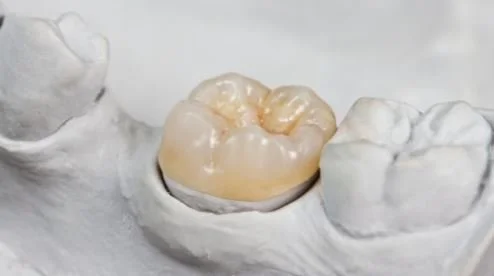Should I get a Filling? Inlay? Onlay? Crown? HELP!
Dental Fillings are the most basic way to restore a tooth. The decay is removed from the tooth and a restoration can be placed the same day. The tooth can be filled with composite (white filling) or Amalgam (silver filling). These procedures can most of the time be done in one visit. If the decay is small composites are a great way to restore a tooth! When the patient is a heavy grinder the filling materials tend to wear out faster from heaving grinding and chewing than a ceramic restoration like an inlay!
Composite Filling on Molar
We usually opt for an inlay when a tooth has too much damage to support a normal filling, yet still has enough strength to not require a crown. Inlays are typically made of porcelain and gold. Once the decay is removed the doctor will take an impression to fabricate a custom restoration made by the lab to restore the lost tooth structure . The inlay is handmade by the lab and sent back to be cemented into the tooth by the dentist! We usually opt for porcelain for our inlays because it is invisible on the tooth and is more durable than composite resin.This procedure takes great skill and should be done by a prosthodontist who is highly trained and skilled in these restorations. Inlays are strong and are a great treatment option to preserve maximum tooth structure.
Porcelain Inlay on Molar
Onlays are used when more structure is needed to be replaced than an inlay, but it is still not enough structure to be called a crown. We like onlays because they can enable us to save the tooth, actually strengthening it, without having to resort to a crown.The Onlay just like the inlay can be made out of ceramic (ex: emax) or metals (ex: gold). They take two appointmetnts to fabricate. This is an important option to consider because we should always conserve the maximum amount of tooth structure. Making the onlay of ceramic/porcelain allows the restoration to be bonded to the tooth. This bonding process may actually improve the strength of the tooth and help seal the onlay to the tooth.
Onlay on a Molar made with Emax
Crowns cover or "cap" a tooth to restore the normal function and appearance of the tooth. Crowns may be made as all metal, porcelain fused to metal, or all-ceramic (porcelain). Crowns are indicated for teeth with very large fillings, teeth that have had a root canal, fractured teeth, worn teeth due to grinding, and misshapen and/or discolored teeth.
Molar Crown in Emax
At Gold Coast Prosthodontics of Long Island, we use inlays and onlays as options for restoring normal tooth structure when a tooth is decayed or otherwise damaged. These are alternatives to the more aggressive treatment of a crown. Prosthodontists are highly skilled in preparing the teeth conservatively for inlays and onlays. An inlay or onlay can fully restore your ability to bite and chew. It can also strengthen your weakened tooth and prevent further structural damage. At the same time, these restorations are conservative alternatives to dental crowns. If you are interested in learning more about dental inlays, onlays, and crowns and what procedure is best for you, get started by making an appointment with us!
Inlays, onlays, and Crowns
Q and A
Inlays vs Regular fillings
Porcelain inlays are superior to traditional amalgam or composite fillings in many ways:
Inlays are more durable than regular fillings.
Inlays don’t require removal of as much of the healthy natural tooth as is required when placing a filling.
They don’t contract and expand with hot and cold foods and beverages as silver amalgam does, so they don’t potentially crack your teeth over time.
In most cases inlays actually strengthen your tooth, whereas fillings weaken it.
Inlays can replace larger areas of decay without weakening the tooth, whereas overly large fillings can seriously weaken a tooth.
Porcelain inlays, like composite fillings, are not detectable on your tooth, unlike amalgam.
Onlays VS Crowns
At Gold Coast Prosthodontics of Long Island, we use onlays in lieu of crowns if possible. Porcelain onlays provide all the advantages of inlays when compared to typical amalgam fillings, and they are a more affordable alternative to a crown. To make room for a crown, we remove a portion of the healthy tooth on all sides and the top. The crown then covers the entire visible portion of the tooth. An onlay only replaces the decayed portion of the tooth, yet is still invisible when looking at the tooth.
Schedule a Consultation
For more information about inlays and onlays, call Gold Coast Prosthodontics of Long Island at 516-920-2400 to schedule a consultation with Dr. Tchorbajian!





